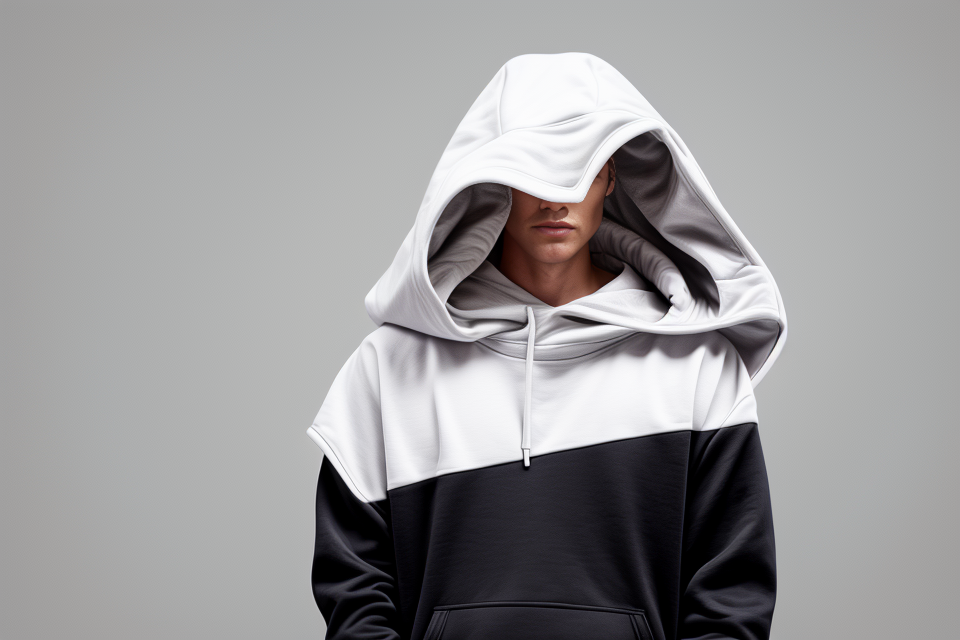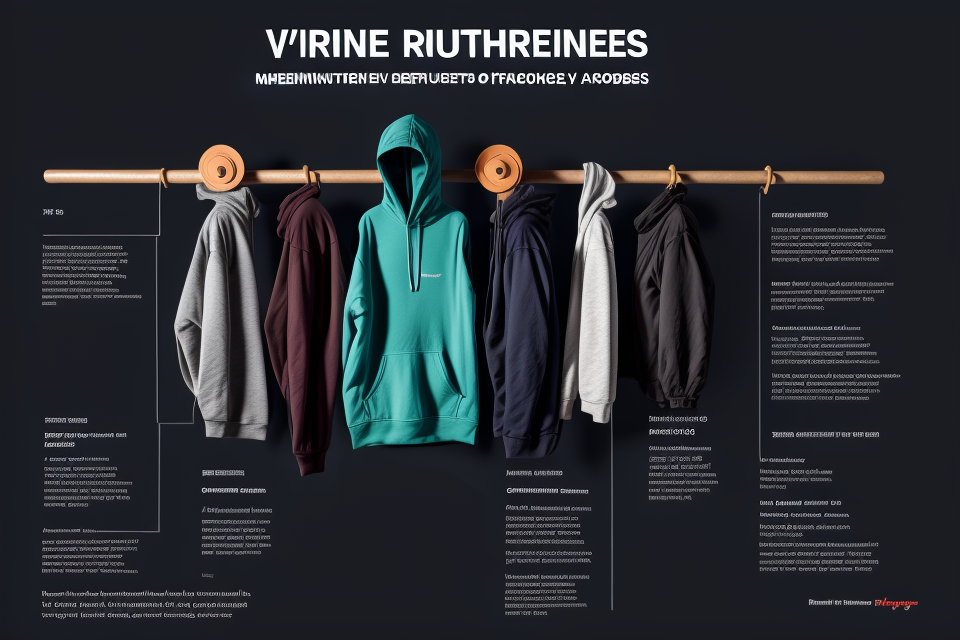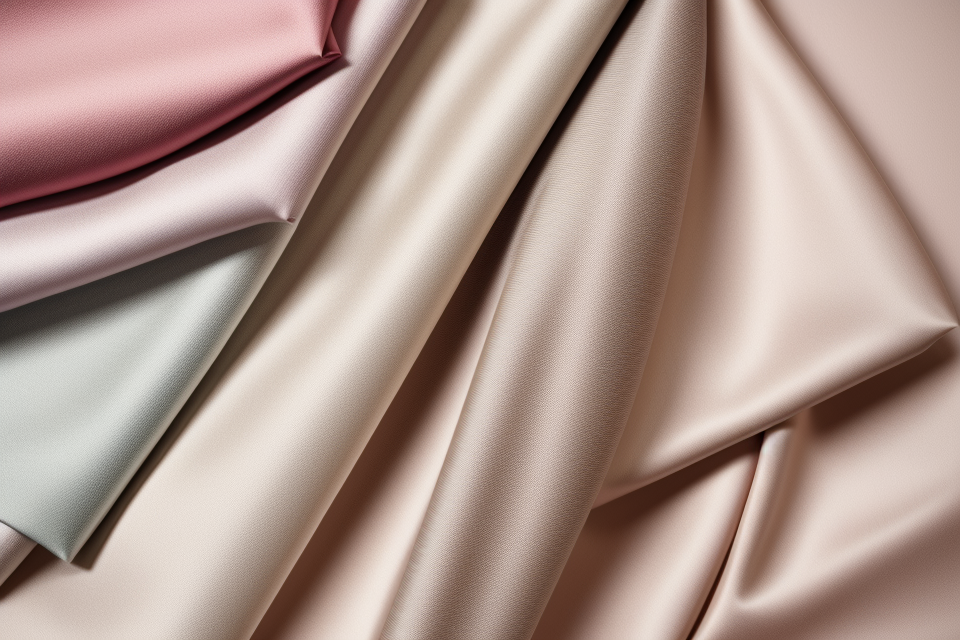
Hoodies have become a staple in everyday fashion, providing both comfort and style. But have you ever wondered why hoodies often have polyester as a primary material? Polyester, a synthetic fiber, has become a popular choice for hoodie production due to its unique properties. In this article, we’ll explore the reasons behind the prevalence of polyester in hoodies and what makes it such a desirable material for clothing. So, buckle up and get ready to uncover the secrets behind the polyester-hoodie connection!
Hoodies are often made of polyester because it is a durable, moisture-wicking fabric that is resistant to shrinking and wrinkling. Polyester is also relatively inexpensive to produce, making it a popular choice for clothing manufacturers. Additionally, polyester can be easily dyed and printed on, allowing for a wide range of colors and designs in hoodies. The combination of these properties makes polyester an ideal material for hoodies, which are often worn for casual, everyday wear and may be washed frequently.
The benefits of polyester in hoodies
Polyester is a popular choice for hoodies due to its various benefits. It is a synthetic fabric that is made from polymers derived from oil, and it is known for its durability, versatility, and resistance to wrinkles. Here are some of the reasons why polyester is often used as a primary material in hoodies:
Affordability
One of the primary reasons why polyester is used in hoodies is that it is a cost-effective option. It is cheaper to produce than natural fabrics like cotton, and it is also more durable, which means that it can withstand frequent wear and tear. This makes it an ideal choice for hoodies, which are often worn regularly and may be washed frequently.
Durability
Polyester is known for its durability, which makes it an excellent choice for hoodies. It is resistant to tearing and ripping, and it can withstand a lot of wear and tear without showing signs of wear. This means that hoodies made from polyester can last for a long time, and they can be worn regularly without having to be replaced frequently.
Versatility
Polyester is a versatile fabric that can be used to create a wide range of hoodies. It can be blended with other fabrics like cotton or spandex to create a variety of textures and finishes. This means that hoodies made from polyester can be designed to suit different styles and preferences, and they can be worn in a variety of settings.
Resistance to wrinkles
One of the advantages of polyester is that it is resistant to wrinkles. This means that hoodies made from polyester will maintain their shape and appearance even after being washed or worn for extended periods. This makes it an ideal choice for hoodies, which are often worn on a regular basis and may be washed frequently.
Quick-drying
Polyester is a quick-drying fabric, which makes it an excellent choice for hoodies. This is because it dries quickly, which means that it can be worn after washing without having to wait for a long time. This is a convenient feature for hoodies, which are often worn as a casual, everyday garment.
In conclusion, polyester is a popular choice for hoodies due to its various benefits. It is affordable, durable, versatile, resistant to wrinkles, and quick-drying, which makes it an ideal choice for hoodies.
Polyester is a highly durable material that is often used in the production of hoodies. One of the main reasons for this is its resistance to wear and tear. This means that polyester hoodies can withstand a lot of use and last for a long time, even with regular wear and washing.
Additionally, polyester is a long-lasting material that does not easily tear or fray. This makes it ideal for hoodies, which are often worn in active situations, such as during sports or outdoor activities. The durability of polyester hoodies means that they can withstand the rigors of these activities and keep the wearer warm and comfortable.
Another advantage of polyester’s durability is that it is easy to care for. Polyester hoodies can be washed and dried without shrinking or losing their shape, which means they will retain their size and fit for a long time. This makes them a practical choice for those who want a hoodie that will last for a long time and not require frequent replacement.
In conclusion, the durability of polyester is one of the main reasons why it is often used as a primary material in hoodies. Its resistance to wear and tear, long-lasting qualities, and ease of care make it an ideal choice for those who want a hoodie that will last for a long time and withstand regular use and washing.
Moisture-wicking properties
Polyester is a synthetic fabric that is widely used in the production of hoodies due to its ability to effectively manage moisture. This property is crucial for hoodies, as they are often worn during activities that cause perspiration, such as exercising or participating in outdoor sports.
One of the primary benefits of polyester is its ability to repel water and keep the wearer dry. This is achieved through the construction of the fabric, which has a smooth surface that does not allow moisture to penetrate easily. As a result, polyester hoodies are highly effective at wicking moisture away from the body, ensuring that the wearer stays dry and comfortable.
In addition to keeping the wearer dry, polyester’s moisture-wicking properties also improve comfort in damp conditions. This is particularly important for outdoor activities, as the wearer may be exposed to rain or sweat. By quickly wicking moisture away from the body, polyester hoodies help to regulate body temperature and prevent the wearer from feeling chilled or uncomfortable.
Overall, the moisture-wicking properties of polyester make it an ideal material for hoodies, as it allows the wearer to stay dry and comfortable during a wide range of activities.
Lightweight and packable
Polyester is a lightweight fabric that is commonly used in the production of hoodies. One of the main advantages of using polyester in hoodies is that it is highly packable. This means that hoodies made from polyester can be easily packed and transported, making them an ideal choice for those who are always on the go.
One of the reasons why polyester is so packable is that it is a synthetic fabric that is made from a type of plastic. This makes it highly durable and resistant to wrinkles, which means that it can be easily folded or rolled up without getting damaged. In addition, polyester is also a quick-drying fabric, which means that it can be easily packed away after wearing and then quickly dried out when needed.
Another advantage of polyester’s lightweight and packable nature is that it allows for greater flexibility in terms of how and where hoodies can be worn. For example, hoodies made from polyester are ideal for traveling, as they can be easily packed into a suitcase or backpack and then quickly worn when needed. They are also great for outdoor activities such as hiking or camping, as they can be easily carried in a backpack and then quickly put on when the temperature drops.
Overall, the lightweight and packable nature of polyester makes it an ideal choice for hoodies, as it allows for greater flexibility in terms of how and where they can be worn. Whether you are traveling, hiking, or simply running errands, a polyester hoodie is a great choice for staying comfortable and stylish on the go.
Easy to care for
Polyester is a popular choice for hoodies because it is a low-maintenance fabric that is easy to care for. This means that hoodies made from polyester can be machine washed and dried, making them a convenient option for busy individuals who don’t have a lot of time to devote to laundry.
One of the key benefits of polyester is that it is a durable fabric that resists wear and tear. This means that hoodies made from polyester can withstand repeated washing and still look and feel like new. Additionally, polyester is a moisture-wicking fabric, which means that it can help keep you dry and comfortable by drawing sweat away from your body.
Another advantage of polyester is that it is a wrinkle-resistant fabric. This means that hoodies made from polyester will retain their shape and size, even after multiple washes. This makes them a great option for people who are always on the go and don’t have time to iron their clothes.
Overall, the ease of care for hoodies made from polyester makes them a practical and convenient choice for anyone who wants a comfortable and long-lasting garment that is easy to maintain.
Polyester’s drawbacks and alternatives
While polyester is a popular choice for hoodies due to its durability and affordability, it is not without its drawbacks. Some of the disadvantages of using polyester as a primary material for hoodies include:
- Lack of breathability: Polyester is a synthetic fabric that does not allow for good air circulation. This can make it uncomfortable to wear in hot weather or during physical activity.
- Poor moisture-wicking properties: Polyester is not very effective at wicking moisture away from the body, which can lead to discomfort and odor buildup.
- Lack of stretch: While some polyester fabrics may have a small degree of stretch, they are generally less flexible than other materials like cotton or spandex. This can make them less comfortable to wear and limit their range of motion.
As a result of these drawbacks, many people look for alternatives to polyester when choosing hoodies. Some popular alternatives include:
- Cotton: Cotton is a natural fabric that is known for its breathability and moisture-wicking properties. It is also generally more comfortable to wear than polyester, although it may not be as durable.
- Bamboo: Bamboo-based fabrics are becoming increasingly popular due to their softness, breathability, and moisture-wicking properties. They are also environmentally friendly, as bamboo is a fast-growing and sustainable material.
- Synthetic blends: Some hoodies are made from a blend of synthetic and natural fibers, such as cotton and polyester or cotton and spandex. These blends can offer the best of both worlds, with the durability of polyester and the comfort of cotton.
Ultimately, the choice of material for a hoodie will depend on personal preferences and the intended use of the garment. While polyester may be a popular choice due to its affordability and durability, there are many alternatives available for those who prioritize comfort and breathability.
Drawbacks
Polyester, despite its many benefits, also has several drawbacks that make it less desirable for certain applications. Some of the most notable drawbacks of polyester include:
- Stiffness and lack of comfort: One of the most common complaints about polyester is that it can feel stiff and uncomfortable to wear. This is because polyester fibers are less flexible than natural fibers like cotton or wool, which can make them feel less breathable and more restrictive. This can be particularly problematic for people who are sensitive to texture or fabric feel, as the stiffness of polyester can be particularly noticeable.
- Poor breathability: Another issue with polyester is that it is not as breathable as some other materials. This is because polyester fibers are less porous than natural fibers, which means they don’t allow as much airflow. This can make polyester clothing feel hot and uncomfortable to wear in warm weather, and it can also make it more difficult for sweat to evaporate, which can lead to odor and discomfort.
Overall, while polyester has many benefits as a fabric, its drawbacks can make it less suitable for certain applications, particularly when comfort and breathability are important considerations. As a result, many people look for alternatives to polyester when possible, particularly for clothing that will be worn in warm or humid conditions.
Alternatives
When it comes to hoodies, polyester is a popular choice due to its durability, moisture-wicking properties, and resistance to wrinkles. However, there are alternatives to polyester that offer different benefits.
Cotton
Cotton is a natural fiber that is soft, breathable, and comfortable to wear. It is also biodegradable and can be recycled. Cotton hoodies are a popular alternative to polyester because they are lightweight and comfortable to wear. However, cotton hoodies are not as durable as polyester hoodies and may shrink or wrinkle easily.
Fleece
Fleece is a synthetic material that is soft, warm, and lightweight. It is also breathable and moisture-wicking, making it a good choice for outdoor activities. Fleece hoodies are a popular alternative to polyester hoodies because they are warm and comfortable to wear. However, fleece hoodies are not as durable as polyester hoodies and may pill easily.
Blends with other materials
Another alternative to polyester hoodies is blending with other materials such as cotton, wool, or spandex. These blends offer a combination of the benefits of both materials, such as the softness of cotton and the warmth of wool. Blended hoodies are a popular choice because they offer a range of benefits, such as comfort, durability, and moisture-wicking properties. However, blended hoodies may be more expensive than hoodies made from a single material.
Factors affecting hoodie material choice
Polyester is a popular choice for hoodie material due to several factors. Some of the key factors that influence the choice of material for hoodies include:
- Durability: Polyester is a durable fabric that can withstand a lot of wear and tear. It is resistant to tearing and fading, which makes it an ideal choice for hoodies that are intended to last a long time.
- Moisture-wicking properties: Polyester is a moisture-wicking fabric that helps to keep the wearer dry and comfortable. This is particularly important for hoodies that are designed for outdoor activities such as hiking or running.
- Breathability: Polyester is a breathable fabric that allows air to circulate around the body. This helps to regulate body temperature and prevent overheating.
- Cost: Polyester is a relatively inexpensive fabric, which makes it an attractive option for clothing manufacturers. It is also easy to care for, which reduces the cost of maintenance over time.
- Style: Polyester is a versatile fabric that can be used to create a wide range of styles and designs. It can be made to look and feel like cotton, for example, or it can be used to create a more technical, performance-oriented fabric.
Overall, the combination of durability, moisture-wicking properties, breathability, cost, and style make polyester an attractive choice for hoodie material. However, it is important to note that other factors may also influence the choice of material, such as the intended use of the hoodie, the climate in which it will be worn, and personal preferences.
Climate and activity level
Warm climates may favor lighter, breathable materials
In regions with warmer climates, it is essential to choose materials that allow for airflow and do not trap heat. This makes lighter, breathable materials such as cotton or cotton blends ideal for hoodies. These fabrics allow for good ventilation, which helps regulate body temperature and keeps the wearer cool and comfortable.
Cooler climates may prefer insulating materials
In cooler climates, insulation is key to keeping the body warm. Hoodies made from materials like polyester, fleece, or wool are preferred as they provide insulation and retain heat. These materials have a higher thermal resistance, which helps keep the wearer warm in colder temperatures. Additionally, they can also be layered with other clothing for added warmth.
High activity levels may require moisture-wicking and quick-drying fabrics
Individuals with high activity levels, such as athletes or those who engage in outdoor activities, need hoodies that can keep up with their movements. In this case, moisture-wicking and quick-drying fabrics are ideal. Materials like polyester and polyester blends have excellent moisture-wicking properties, which help draw sweat away from the body and keep the wearer dry. These fabrics also dry quickly, making them perfect for post-workout or outdoor activities.
Brand and cost considerations
Different brands may use different materials for their hoodies
Various brands offer hoodies made from different materials to cater to the preferences of their target audience. For instance, some high-end brands may opt for luxurious materials like cashmere or merino wool to provide a premium experience, while others may use cheaper alternatives like cotton or polyester to keep costs low. The choice of material can significantly impact the final product’s look, feel, and durability, which may influence a consumer’s purchasing decision.
Cost can also play a role in material choice
The cost of production is an essential factor in determining the material used for a hoodie. Polyester is a popular choice for hoodies because it is relatively inexpensive compared to other materials. It is a synthetic fiber that can be mass-produced, making it more accessible and cost-effective for manufacturers. As a result, hoodies made from polyester are often more affordable, attracting price-conscious consumers who prioritize value for money.
However, it is essential to note that the cost of a hoodie is not solely determined by the material used. Other factors, such as labor costs, marketing expenses, and distribution fees, can also impact the final price. Consequently, while polyester may be a more affordable option for producing hoodies, the final cost of the garment may still vary depending on these additional factors.
FAQs
1. What is polyester?
Polyester is a type of synthetic fabric that is made from polymers of esters. It is known for its durability, resistance to wrinkles, and ability to be stretched in multiple directions.
2. Why is polyester used in hoodies?
Polyester is often used in hoodies because it is a lightweight, breathable fabric that can keep you warm in cooler temperatures. It is also relatively inexpensive to produce, making it a popular choice for clothing manufacturers. Additionally, polyester is resistant to shrinking, wrinkling, and fading, which makes it a practical choice for a hoodie that will be worn frequently and washed regularly.
3. Is polyester a good material for hoodies?
Polyester is a good material for hoodies because it is lightweight, breathable, and warm. It is also durable and resistant to shrinking, wrinkling, and fading. However, some people may find that polyester hoodies can be a bit rough on the skin and can cause allergic reactions in some individuals. Additionally, polyester is not as warm as other materials like wool or fleece, so it may not be the best choice for very cold weather.
4. Are there any alternatives to polyester in hoodies?
Yes, there are alternatives to polyester in hoodies. Some common alternatives include cotton, wool, and fleece. Cotton hoodies are soft and comfortable, but they may not be as warm as polyester hoodies and may wrinkle easily. Wool hoodies are warm and breathable, but they can be expensive and may not be as durable as polyester. Fleece hoodies are warm and lightweight, but they may not be as durable as polyester and may pill easily. Ultimately, the best material for a hoodie will depend on the individual’s personal preferences and the intended use of the hoodie.


